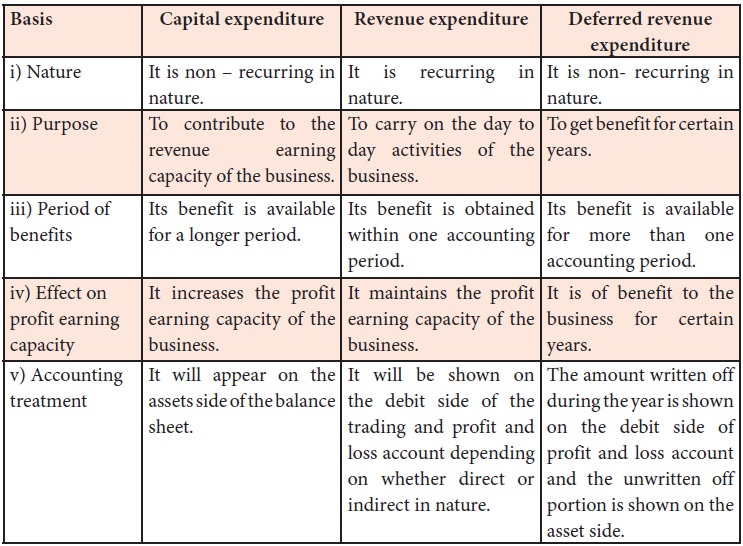Accountancy - Classification of expenditure | 11th Accountancy : Chapter 11 : Capital and Revenue Transactions
Chapter: 11th Accountancy : Chapter 11 : Capital and Revenue Transactions
Classification of expenditure
Classification of expenditure
Expenditures may be classified into the following three categories:
i.
Capital
expenditure
ii.
Revenue
expenditure
iii.
Deferred
revenue expenditure.

1. Capital expenditure
It is an expenditure incurred during an accounting period, the benefits
of which will be available for more than one accounting period. It includes any
expenditure resulting in the acquisition of any fixed asset or contributes to
the revenue earning capacity of the business. It is non- recurring in nature.
Features of capital expenditure
Following are the features of
capital expenditure:
·
It gives
benefit for more than one accounting period.
·
It
includes acquisition of fixed assets and all expenditure incurred upto the
point an asset is ready for use.
·
It
contributes to the revenue earning capacity of the business.
·
It is
non-recurring in nature.
·
It is
shown on the assets side of the balance sheet.
Examples
·
Cost of
acquisition of land and building.
·
Cost of
acquisition of office equipment, computer and air-conditioner.
· Cost of acquisition of plant and machinery including installation charges and trial run.
2. Revenue expenditure
The expenditure incurred for day to day running of the business or for
maintaining the earning capacity of the business is known as revenue
expenditure. It is recurring in nature. It is incurred to generate revenue for
a particular accounting period. The revenue expenditure may be incurred in
relation with revenue or in relation with a particular accounting period. For
example, cost of purchases is a revenue expenditure related to sales revenue.
Rent and salaries are related to a particular accounting period.
Features of revenue expenditure
Following are the features of
revenue expenditure:
·
It is
recurring in nature.
·
It is
incurred for maintaining the earning capacity of the business.
·
Its
benefit expires in the same accounting period.
·
It is
shown on the debit side of the trading and profit and loss account.
Examples
·
Purchase
of goods for resale.
·
Administrative,
selling and distribution expenses.
·
Manufacturing
expenses.
3. Deferred revenue expenditure
An expenditure, which is revenue expenditure in nature, the benefit of
which is to be derived over a subsequent period or periods is known as deferred
revenue expenditure. The benefit usually accrues for a period of two or more
years. It is for the time being, deferred from being charged against income. It
is charged against income over a period of certain years.
Features of deferred revenue expenditure
Following are the features of
deferred revenue expenditure:
·
It is a
revenue expenditure, the benefit of which is to be derived over a subsequent
period or periods.
·
It is not
fully written off in the year of actual expenditure. It is written off over a
period of certain years.
·
The
balance available after writing off (i.e., Actual expenditure - Amount written
off) is shown on the assets side balance sheet.
Examples
·
Considerable
amount spent on advertising
·
Major
repairs to plant and machinery
Comparison of capital, revenue and deferred revenue expenditure
Following are the points of comparison among capital, revenue and
deferred revenue expenditure:

Related Topics